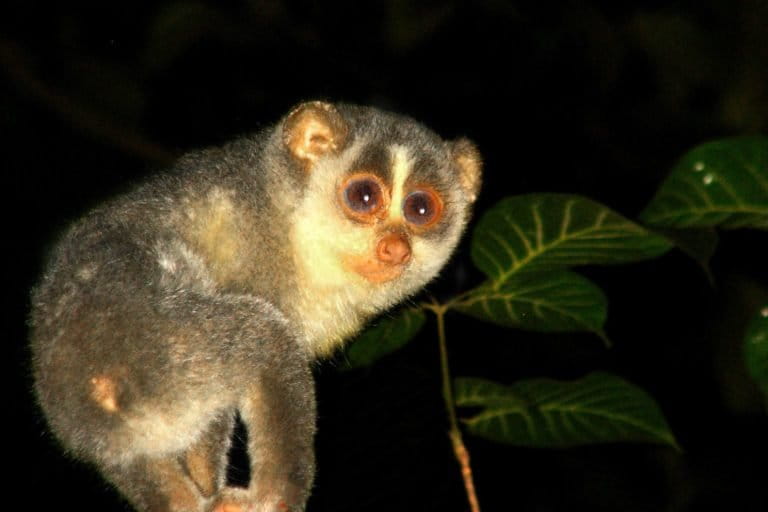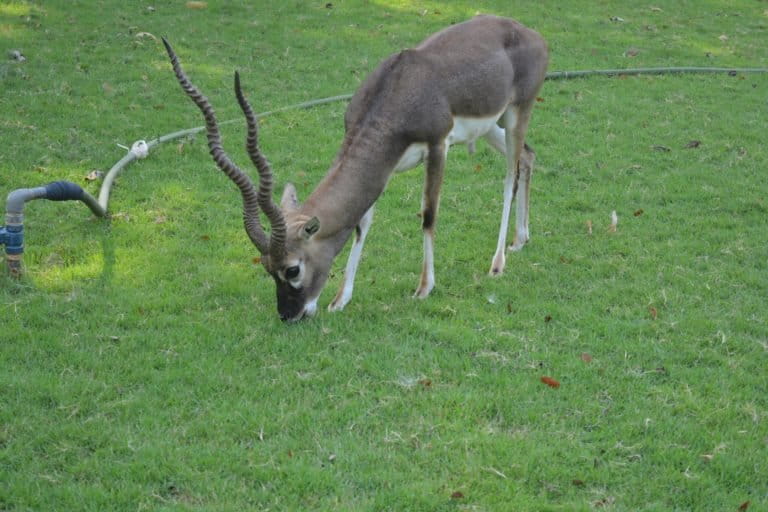- Many Indian higher educational institution campuses harbour wildlife.
- Experts stress wildlife-rich campuses offer opportunities for conservation with development — if planned properly.
- A comprehensive management plan is important to address human-wildlife conflicts on campus.
Snow trout in cold Himalayan waters, bat roosts, crocodiles basking in the sun, sprinting blackbucks, and prowling leopards — India’s higher education campuses are home to diverse wildlife species, warranting management to ensure their survival.
Faculty members, students and staff with the help of professionals have been working hands-on to promote coexistence, which is often fraught with conservation challenges. Campuses range from having designated on-site biodiversity-rich areas that have formal conservation plans (like in IIT-Mandi), to sporting patches of green within urban spaces (Indian Institute of Science, Bengaluru). Several of these microcosms of biodiversity serve as living labs of sustainability research, especially when a campus is situated adjacent to a protected area such as IIT Bombay (Mumbai).
Jayshree Vencatesan, managing trustee of Chennai-based Care Earth Trust that works with institutes to draft campus eco-management plans (EMPs), emphasised that compliance with protocols to manage wildlife on campus is crucial to enable harmonious wildlife-human coexistence.
“We are not saying that whatever we recommend in the EMPs will prevent wildlife-human conflicts. Conflicts will happen at human-wildlife interfaces. But at least you will know what kind of conflict you can expect and what you can do about it. There is an opportunity to evolve these campuses into refugia for biodiversity. We should not lose out on this opportunity to reconcile conservation with development,” Vencatesan told Mongabay-India.
While India’s National Wildlife Action Plan (2017-2031) calls for extending protected area network it also recognises that wildlife conservation has to go beyond protected areas to the larger landscapes in which these are embedded and that wildlife in urban and other human-dominated landscapes needs more conservation attention.
Interdisciplinary scientist Kaberi Kar Gupta, founder-director at the Urban Slender Loris Project, batted for more collaboration between urban planners and ecologists to evolve campuses into safer spots for wildlife. Kar Gupta leads a citizen science project to document the presence of slender loris in the bustling metropolis of Bengaluru. The species was once abundant in the city but is now confined to patches now, including on the Indian Institute of Science (IISc) campus. With their burning bright round eyes, the protected nocturnal primates face threats from poachers and the pet trade industry.
“Slender lorises love tree canopies and the IISc campus offers canopy cover despite an increase in infrastructure. They are significantly abundant on campus. The institute also allows us to conduct ‘loris walks’ with citizens that help us build stronger engagement with the community,” Kar Gupta told Mongabay-India.

The IISc campus, situated in the middle of Bengaluru, also hosts a high diversity of bat species, which chiropterologist Rohit Chakravarty finds fascinating. Almost all the bats found on campus are generalist species. They seem to like the mix of greenery, scrubland, heritage buildings, and abandoned buildings, which together offer good foraging and roosting habitats.
Chakravarty has recorded the presence of Indian pygmy bat (Pipistrellus tenuis), Egyptian free-tailed bat (Tadarida aegyptiaca), Schneider’s leaf-nosed bat (Hipposideros speoris), and Indian flying fox (Pteropus medius) among others on the campus.
“You typically don’t find leaf-nosed bats in noisy urban spaces, but in the ‘forested’ and peaceful campus, they’ve managed to find refuge. The free-tailed bat is another interesting species. It likes to roost in rafters and drooping ceilings of houses,” said Chakravarty. “The architecture of the main library is just the kind that free-tailed bats like to roost in. A little after dusk, these bats emerge and forage around the bright lights of the library’s courtyard.”
Students and faculty manage wildlife
On the slopes of the Western Ghats, adjacent to the Sanjay Gandhi National Park in the metropolis of Mumbai, is IIT Bombay, surrounded by hills and Vihar and Powai lakes on either side. The campus prides itself on sheltering a range of wildlife: from resident and migratory birds including ducks, terns and sandpipers, monitor lizards, rhesus macaques to marsh crocodiles, and the occasional visits by leopards from the national park. According to an estimate, the Powai lake is home to as many as 40 marsh crocodiles.
A decade-old WWF study of biodiversity on the campus commissioned by the Institute’s Environment Advisory Committee points to rodents and domestic dogs as the most dominant mammals on the campus, followed by the cattle. It recorded 843 species; 44 percent comprised flora, 39 percent of invertebrate fauna, and 17 percent vertebrate fauna. Faculty members who have been on campus for over a decade and are actively involved in animal welfare activities have observed a decline in the wildlife diversity on campus compared to the study, mainly due to the expanding infrastructure.
“There has been a drastic change in the last seven years. Only two (resident) duck species (spot-billed duck and the lesser whistling duck) are now reported,” said S Sivaramakrishnan, a faculty at IIT Bombay’s department of mathematics. He has been with the Institute for 12 years and is part of the campus animal welfare group.
The animal welfare group, composed of faculty members and students, notes that while most campus residents “appreciate the presence of various animals, there are also instances of conflicts” between monkeys and humans, dogs and humans, and cattle-humans. For example, cows have entered hostels, classroom, and stray bulls have attacked a student on campus.
The group handles animal rescue, feeding stray dogs on campus, and neutering and vaccinating dogs with the help of professionals. Campus residents rely on the group members to respond to calls for rescuing and managing wildlife that enter into their homes and gardens.
Sivaramakrishnan and Madhu Belur, faculty at the electrical engineering department, who are actively involved with the group, are equipped to handle non-venomous snakes. For venomous snakes, they call specific NGOs. Except for the saw-scaled viper, Sivaramakrishnan has spotted three of the four venomous snakes found in India, on-campus: Russel’s viper, krait, and the common Indian cobra.
“We have not seen a saw-scaled viper for many years. We have a hospital on campus, but for snake bites, we have access to hospitals closest to the campus,” said Madhu Belur, who has been at IIT Bombay for 15 years. Both Belur and S Sivaramakrishnan vouch for the substantial work put in by students for animal welfare. “Without the students, we are struggling with rescues and feeding during the lockdown. They are well aware of the benefits and challenges of having wildlife around them and participate in the day to day activities to ensure co-existence,” said Belur, adding that leopard activity went up on campus during the COVID-19 lockdown.
Priya Pant, professor at department of Metallurgical Engineering and Materials Science at the Institute, who also works with the welfare group, said long-term measures are crucial to tackling conflicts. “We need to approach the issue through better hostel infrastructure, policies related to animals at the hostel and institute level, and involvement of people working with animal welfare groups,” said Pant, adding that cows and bulls have now been corralled into a ‘goshala’ or shed.

Envision conservation in planning
On the other end of the spectrum, Rishi Valley Education Centre run by the Krishnamurti Foundation of India in rural Andhra Pradesh has a history of living with the wilderness. And many of the upcoming Indian Institute of Technology (IITs) at Dharwad, Palakkad, Jammu, Goa, and Tirupati are working in coherence with customised eco-management plans (EMPs) to guide them on sustainable growth.
“Rishi Valley manages the rich flora and unique reptilian species by way of periodic removal of invasive plants and discouraging cattle grazing within their boundary. All the IIT campuses we worked on are planned in such a way to adapt to wildlife within their boundary (with the help of EMP) and some maintain the contiguity of the adjoining wilderness areas,” said Care Earth Trust’s N Muthu Karthick.
Regular biodiversity and ecological assessments on the campus after the infrastructure has been erected and intensification of remediation works as human footprints increase are recommended, said Karthick. “Wherever we have worked, we have recommended collaboration with the forest department and in fact, we have shared our data with the forest department,” added Vencatesan.
She highlighted IIT-Mandi in Himachal Pradesh in the western Himalayas as a model in building an ecologically sustainable campus. The institute first evolved an EMP and planned the campus infrastructure around it. The campus falls within one of the upland watersheds of the river Beas. A minor tributary called the Kataula ki Khad (a nallah/canal) flows through the campus and drains into the river Uhl, a right-bank tributary of the river Beas.
The nallah and the river Uhl are also important habitats for native Himalayan fish. Two species of snow trouts (Schizothorax richardsonii and Schizothoraichthys labiatus) are the key species on campus as per Care Earth’s assessment. “The river and its ecology have been taken into consideration to design the infrastructure. The planning needs to be in a collaborative mode by building dialogues and involving experts and local stakeholders,” said Vencatesan.
Timothy Gonsalves now retired founder-director of IIT Mandi, recalled how the “breathtaking view of the rugged and remote” Uhl valley in his first visit to the site of the then-upcoming campus in 2010, inspired him to create a world-class institute “without destroying the pristine setting.”We are teaching young students who will build India of the future. We are creating knowledge and technologies for India and the future. It is clear that India and the world need to live in more and more consonance with nature to avoid catastrophes of climate change, pandemics, etc. Living principles is the best way of promoting them. By reconciling development with environmental protection on campus, our students imbibe these principles, we serve as examples for others,” Gonsalves told Mongabay-India.

Conservation plans can be retrofitted
In Chennai, Tamil Nadu, the 630-acre IIT Madras carved out of the Guindy National Park, acknowledges that the campus has an “important role” in protecting the endangered blackbuck (Antilope cervicapra) in “the campus which is their original and native habitat.”
Rapid urbanisation within the campus at the expense of open spaces, speeding vehicles, and stray dogs led to the drastic decline in blackbuck numbers from hundreds in the 1980s to less than 20 in 2003, according to IIT Madras’ wildlife club Prakriti’s webpage. Speeding vehicles and stray dog attacks also imperiled the spotted deer or chital population, which is a species introduced to the area.
The institute roped in Care Earth to carry out a rapid biodiversity assessment in 2006. The blackbuck numbers went up due to a species recovery programme initiated by Care Earth under ecologist Ranjit Daniels. “It was a two-pronged strategy. The grassy patches were identified as inviolate zones (no development zones). The second action was to remove the invasive species Prosopis juliflora. In two years (2006 to 2008), the population went up from 13 to 21,” said Vencatesan. In a follow up to the wildlife management activities on the main campus, the institute has evolved an EMP for the adjacent satellite campus.
Banner image: Leopards from Sanjay Gandhi National Park enter IIT Bombay campus. Their activity increased during the lockdown. Photo by Maheshshinde/Wikimedia Commons.
